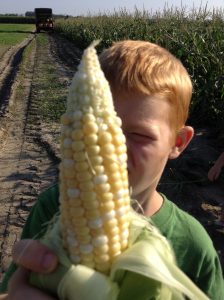Why Your Corn Is Missing Kernels

Jed holds up an ear of corn that is missing kernels on the tip. Turns out there’s a really good reason for that.
Have you ever opened up an ear of corn only to see the tip missing some corn kernels? Or perhaps you see an entire row missing kernels?
Before you blame critters for gobbling up a section of your sweet corn, let me blow your mind with a little farmer trade secret.
There’s actually a really good reason you’re missing kernels… it means those kernels never got pollinated.
Hold the phone! Yes, even sweet corn gets pollinated!
Here’s how it works.
Before the ears ever form on the sweet corn plant below, the plant sends up a “tassel.” This is the male flowering part of the plant.
Down below, as the female husk forms, hundreds of little strings or “silks” appear — these are the very same corn silks you find inside the husk of corn before you eat it.

Sweet corn tassels drop their pollen onto the female ear below to pollinate each silk of the ear.
Corn is primarily pollinated by the wind. As the wind blows from all directions, pollen from the tassel falls down below and lands on the silks of the corn husks. The male “seed” travels down the silk to fertilize the female below.
Now here’s the nugget of coolness: Each little silk leads to one forming kernel on the cob.
That means that each silk has one purpose in life: to grab some pollen from a tassel and fertilize (and form) a kernel of seed on the cob.
If one particular silk doesn’t get pollinated, then that kernel won’t develop!
Your ear of corn has all its kernels only if the tassel dropped enough pollen to pollinate all the silks of that plant.
One of our CSA members Jess Eley texted me last week to ask why her sweet corn in her garden didn’t turn out right. There were entire sections of the ear missing…
The reason for this is probably because it’s very hard to grow fully developed ears of sweet corn unless you have rows and rows lined up together. Because all sides of those ears need to be pollinated, you’ll often see whole sections missing in garden-grown corn because gardeners often don’t realize they need to plant it in blocks (instead of rows).
You can try hand-pollinating the ears. But this is one of those instances where we really rely on the wind to blow back and forth to do the work.
Sweet corn ears are biggest in the month of August. This is due to the amount of sunlight the ears have been exposed to. If you’re buying corn in bulk — August is your best month to buy, because you’ll be getting the biggest bang for your buck.
You can pre-order bushels of corn (5 dozen) for around $30 in our online store. (Open May-November)
Subscribe to our online store here so you can hear about our weekly availability for produce!
